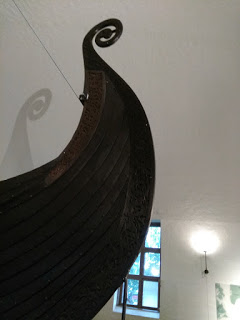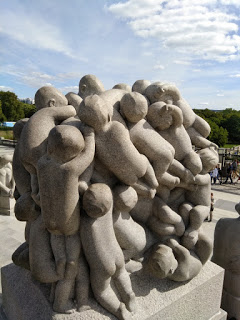August 15 – 18, 2018. Oslo, Norway
 |
| Entering the courtyward, on the way to Cafe Mir |
By Paul Acquaro
It was Saturday, the last of the Blow Out festival, when an opportunity arose to sit down with drummers and festival organizers Paal Nilssen-Love and Stale Liavik Solberg at a small trattoria in the hip Grünerløkka neighborhood of Oslo. I had my list of questions and my recorder ready.
We exchanged greetings and looked over the menu, debated current hunger levels, and assessed whether there was enough time to pick up some wine before the early cut off. Then, a group of men, seemingly direct from a sporting event, entered the restaurant. They took up the longest side of the small room, and any plans to record a proper interview drowned in the din.
Fortunately, it was impossible not to have an enjoyable and memorable time with Paal and Stale. Over the course of the meal, our conversation ranged from the history of the festival, to the attention to the artists needs that the organizers – who are artists as well – can provide, to the enthusiastic community that comes together for the festival every year.
Onsdag 15. August.
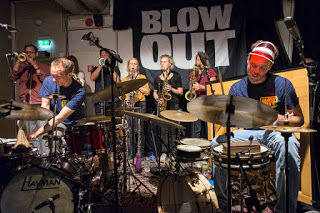 |
| PAN-SCAN Ensemble. By Dawid Laskowski. |
The nine-piece PAN-SCAN Ensemble maxed out the stage space. Sharing it with two drummers (Nilssen-Love and Solberg) and a pianist (Sten Sandell), there wasn’t that much more room for three trumpeters (Thomas Johansson, Goran Kajfes, and Emil Strandberg) and three saxophonists (Lotte Anker, Signe Emmeluth, and Julie Kjær), but they made it work, and it worked well. The group got its start two years ago at the festival and subsequently released the excellent Time and Space last year. This time around, the freely improvising ensemble began with a small scatter of sounds – a sharp crack from a drum, blast from a trumpet, and a snarl from a sax followed by a gradual building intensity. The music is a study in contrasts, each instrument playing a slightly different role, finding ways to differentiate their sounds: high pitched chirps from the saxes collided with the piano, while the trumpets proved to be highly responsive, engaging in dialog with two drummers. Relaxed and ready, they reached a musical peak as individual voices rose above the core of Stendell, Nilssen-Love, and Solberg.
 |
| Hamid Drake with Sambou Jobarteh and Bjarne Larsen. By Kjetil Tangen |
Somehow, Mir got even more crowded as the next group came on. DNA? AND?‘s Soundcloud page describes them as “an Oslo-based improv-collective with alternating members and an abundance of chromosomes.” Organized by multi-instrumentalist Harald Fetveit, the group features an evolving membership of young people with Down Syndrome. Invited guest, Chicago based drummer Hamid Drake sat in with the group, and later that evening gave a heartfelt thank you for the opportunity to play with the young musicians, remarking that “creativity is unlimited, it rolls and flows in many ways.” The group’s performance centered around Drake’s hand drumming, and was augmented by bass, piano, vocals, and guitar, and a little later, bells and flute. The groups confidence grew as they performed, and by the end, they were solidly rocking along.
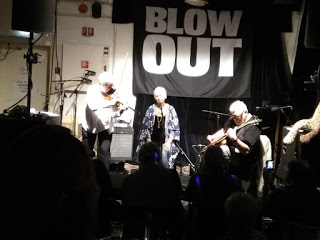 |
| Trio Blurb: Mia Zabelka (violin), Maggie Nicols (vocal), John Russell (guitar) |
Singer Maggie Nicols was front and center for Trio Blurb, situated between the sweeping violin work of Mia Zabelka and the fastidious work by guitarist John Russell. Nicol’s vocals at times mimicked the violin’s sweeping bowing and dramatic plucks, while Russell kept busy with a uninterrupted flow of notes and chord fragments. Nicols embodied the sound she made, outlining them with hand gestures and emotive expressions, while Russell, curled about his lovely hollow-body guitar, was a constant source of musical motion, hovering between dissonant and jarringly ear-pleasing tones. The trio, which has been playing together for several years, just put out a new recording, W (Live), which Russell dryly observed had showed up just in time for him to schlep to Oslo.
 |
| Kent Kessler, Hamid Drake, and Ken Vandermark, aka the DKV trio. By Dawid Laskowski. |
It’s been a long held dream of mine to hear the legendary DKV trio in concert. Saxophonist Ken Vandermark’s oldest working group brings together drummer Hamid Drake and bassist Kent Kessler in a rather straightforward sax-bass-drum trio, which has released some stunning recorded work over the years (check out the incredible Sound-in-Motion box set from 2014 or last years’ Latitude 41.88) and on this first night of the festival, my dream came, in vivid form, true.
It was, an invigorating night, and mere foreshadowing for the rest of the week.
Torsdag 16. August.
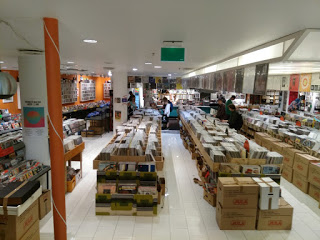 |
| Sensing financial danger … entering Råkk & Rålls |
Thursday was the first day of sight seeing. The city, nestled between green mountains and the fjord affords many avenues for exploration. The Munch Museet, National Gallery, the Viking Ship Museum, botanical gardens, a hike in the hills, boat ride through the fjord, or a tour through the otherworldy Vigeland sculpture park awaited. Obviously, the record stores were visited first: Bare Jazz, a highly curated shop with excellent coffee, and Råkk & Rålls, a sea of treasures.
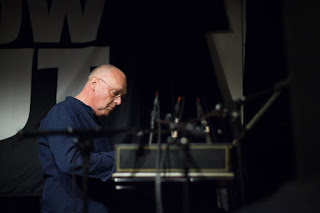 |
| Sten Sandell playing from his “anti-fascistiska sångboken”. By Dawid Laskowski. |
The night began with Sten Sandell playing a series of improvisations that he imbued with a spirit of protest against the current winds of fascism blowing across the once proud “free world” on the Clavichord. The use of the Renaissance era instrument was likely not without its own meaning, even if it was as simple as signal for an end to these current dark ages. At the keyboard, Stendell filled several 10 minute sessions of instant compositions full of tension and rapid arpeggios. Exploiting the percussive side of the instrument, the music at times took on grooves that would give King Crimson a run for its money.
 |
| Hamid Drake, Isabelle Duthoit, and Lene Grenager. By Dawid Laskowski. |
A snappy rim shot, followed by a slow menacing creak from the cello, reset the mood. French vocalist and clarinetist Isabelle Duthoit proceeded to ramp up the menace with what I can only describe as a love song to a zombie – a gargling hiss and high pitched chatter that eventually became the sound of someone being consumed. Reacting to, and at times riling things up, drummer Hamid Drake and cellist Lene Grenager engaged Duthoit with zeal. The cellist sawed at the strings with purpose, often in sync with the vocals. Duthoit pulled off pieces of her clarinet and used them to modulate her voice, and then, when she played the reassembled instrument, the sound was a seamless segue to new textures over the sturm und drang of Drake of Grenager. The phantasmagorical soundscapes were an utterly unforgettable and somehow very satisfying start to the festivals most challenging night of music.
 |
| Paul Lytton, Maggie Nicols |
Drummer Paul Lytton and singer Maggie Nicols’ musical relationship has its roots in the free music scene in London in the 1960s, however, they also last performed as a duo in 1969, at Paal Nilssen-Love’s father’s jazz club in London (more on that soon). According to Nicols however, it only took a bit of reminiscing and warming up to rekindle the creative spark. Nicols, with tap shoes and a purple head wrap, was a steady stream of loosely connected thoughts wrapped up with a bit of physical drama and flair. Lytton seemed to focus intently on the snare drum, which he augmented with a range of percussive paraphernalia. “Rising up from the low,” spoke Nicols suddenly, before falling into deep moans that mimicked Lytton’s rubbing of the bass drum head with his finger tips. A small chuckle rose from the audience as he rhythmically bent a piece of sheet metal. Nicols told a story about drummer John Stevens (of the Spontaneous Music Ensemble) speaking of inner peace with revolutionary type with the punch line of “there is nothing like having inner peace to wage an external war.”
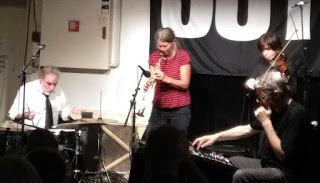 |
| Paul Lovens, Lotte Anker, Katt Hernandez, and Thomas Lehn |
Following a stuttering start, the group of Paul Lovens, Lotte Anker, Katt Hernandez, and Thomas Lehn got going. Analog synth player Lehn adopted a chirpy chime sound that seemed to resonate with saxophonist Anker and her straight alto sax. Lovens playing on a stripped down set was deeply involved with percussive elements and sound making, connected strongly with Hernandez and her violin. Together, the group concentrated on small sounds, dissonant lines, and unexpected but fitting combinations, often finding long droning tones that straddled dissonance. Approximately half way into their performance, Lehn’s fingers were ablaze on his synth’s input and Lovens relaxed into a tight groove. Anker took the opportunity to put a violin bow to her Baritone sax bell, of course. After a long search, the group seemed to find what they were collectively seeking and dug in.
Fredag 17. August:
The day began with a trip to the Viking Ship museum, which was a quick boat ride (or could have been a slightly less exciting trolley ride) to the nearby Bygdøy peninsula, full of historic homes and other nautically inclined museums. Three ships in various states of completeness fill the halls of the museum, and bring to life the myths and legends of the Vikings.
 |
| Terry Nilssen-Love, Audun Vinger, and Paal Nilssen-Love |
 |
| Paal Nilssen-Love, Ole Morten Vågan, Karin Krog |
As she was receiving an honorary sun visor from Solberg (his trademark), an audience member described vocalist Karin Krog to me as jazz royalty in Norway. The eighty-one year singer was small but animated on the stage, and a true surprise. A restless experimenter in the late 1960s, she was at one point on the forefront of avant-garde around Oslo. She became famous for her signing and released many recordings ECM, and lately, has been working her husband and woodwindist John Surman. In the packed confines of Mir, she lit up the stage with her gentle mix of standards and gleefully employed voice modulator. While she was the ‘star’, the work of bassist Ole Morten Vågan and drummer PnL stole the show. Their expressive playing gave the sparse trio a nearly orchestral sound, with Vågan covering a huge swatch of rhythm and melody and PnL swinging pretty hard and filling the remaining gaps. A highlight was a rendition of ‘Goodbye Pork Pie Hat’, the deep bluesy melody was delivered lithely over the rhythm sections’ lush support. The set ended with a gentle modal song about Molde, however the most effective element was that there were no egos on the stage, Krog gave her accompanists plenty of room to explore, and they gave back in multitudes.
 |
| SCATTER: Roger Turner, Dave Tucker, Phil Minton, Pat Thomas |
Vocalist Phil Minton works on the outer edges of the sounds that humans can make. The band, Scatter, was a blast of energy and noise and gave Minton a great deal to work, especially between the interplay of guitarist Dave Tucker and drummer Roger Turner, and Pat Thomas’ light electronics. Minton physically contorted into the sounds he was making, and the band responded musically. Switching between straight ahead pulse and scattered musical scraps, sharp plucks at the guitar stings and thick blocky, clunky power chords.
 |
| Paul Lytton, Kalle Moberg, Philipp Waschmann |
The trio of drummer Paul Lytton, accordionist Kalle Moberg, and violinist Philipp Waschmann brought together two generations of improvisors for a successful set of improvisations. Waschmann and Lytton come from the first generation of British improvising musicians, and Moberg is a young Norwegian player currently in PnL’s Large Unit. They quickly proved to be a nice contrast to the density of the previous group, beginning softly, Lytton and Moberg playing almost without sound, while Waschmann drew long tones from the violin. Then, a burst of energy, Waschmann strumming the violin strings, followed again with scattershot of melodic and textual ideas and a game of connecting with small gestures and sounds, building to an ecstatic high. It will be interesting to see if this is a trio that re-convenes.
 |
| Trespass Trio + Susana Santos Silva |
The Trespass Trio is saxophonist Martin Küchen, bassist Per Zanussi, and drummer Raymond Strid. They have several excellent albums available on Clean Feed records, the latest The Spirit of Pitesti. The trio, is a powerful and moving group in its own right, but adding trumpeter Susana Santos Silva is a stroke of genius as she added a whole other dimension to the music. Starting with the a lower bass rumple, Silva shadowed Küchen’s grave melody, which the group built up slowly to a tense apex. Later, Küchen switched to soprano sax and let out an explosion of notes while Zanussi alternated between languid lines and rapid walks, tugging at the pulse. Throughout the music began with stately songs heads, which seemed to be drawn from their latest album, provided a direction without instruction, and allowing the group to take the breathless audience on a journey.
Lørdag 18. August.
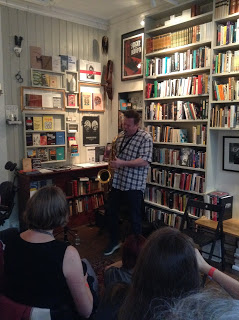 |
| Ken Vadermark @ Cappelens Forslag |
Saturday’s tourism activities were broken up by a wonderful mid-day show at the cozy Cappelens Forslag bookstore, a ‘hole in the wall’ so to speak, filled with charm and well curated display items. Here, tucked between the Pynchon and the Auster, Ken Vandermark delivered a strong, arcing, solo set on tenor sax and clarinet. This was followed by the trio of vocalist Phil Minton, bassist Nina deHeney, and guitarist Håvard Skaset. Space was tight in the steamy shop, but everyone poured out of it satisfied. Surrounding this event, a trip to the newly built Aker Brygge neighborhood and a mandatory pilgrimage to see “The Scream” at the National Gallerie.
 |
| Ståle Liavik Solberg, Tony Buck, Anja Lauvdal |
The last night of the festival concert proper began with drummer Tony Buck on guitar (the Necks drummer has actually added guitar to their recordings and has the group Transmit in which he also plays the instrument), along with drummer Ståle Liavik Solberg and synth and piano player Anja Lauvdal. With an electric guitar on his lap, Buck went at the strings and fretboard with various tools and techniques, creating a tone palette for his bandmates to create music from and around. Lauvdal first concentrated on electronics, manipulating sound waves while Solberg at first laid back, only to start picking up the intensity. Buck responded by playing detuned chords and strumming up a whirl of sound with Laudval. Throughout Solberg kept it simple, sometimes playing just an egg shaker and the occasional cymbal, or a light pattern on the snare, while Laudval switched to piano and provided a more regular pattern. Buck remained the agitator, looping his guitar, adding new textures with different implements, and providing colorful dashes of skronk.
 |
| Phil Minton, Veryan Weston |
Vocalist Phil Minton and painist Veryan Weston have a strong history of making music together going back to the 1980s. Tonight, they began with two songs from the Mike Westbrook’s “Gladday”, a musical setting of William Blakes poems. Their performance was riveting. Minton’s dramatic Baritone voice embodied the spirit of the songs, and Weston’s piano work straddled a line between a “musical” and classical approach. For a third piece, Weston began with a classical interlude but by when Minton joined they have moved entirely into making free associative connections.
 |
| Paul Lovens, Nina de Heney, Ken Vandermark |
Swedish bassist Nina de Heney stood between drummer Paul Lovens and woodwind powerhouse Ken Vandermark for this ad-hoc trio’s set. Switching between bowing and plucking, she rooted the group, offering both pulsating lines, strummed double stops, and swift kicks of energy. Lovens playing was both sensitive and illustrative, providing musical sketches and fills. Vandermark moved from sax to clarinet and back, each time changing the tone and timbre of the group. Their music worked so well, dynamic, melodic, energetic, it seemed like it almost had been written out and rehearsed rather than being the first time the group had played. Vandermark’s saxophone work was full of tension and over bubbling musical broth, their music built, built, built, until it finally boiled over. Seeing Vandermark later, I begged him to release the recording of this set, if there was one.
Oslo based trumpeter Goran Kajfes’ Subtropic Arkestra was a perfect choice to cap off the festival. The large group provided some symmetry to the festival’s kick off with the large Pan Scan Ensemble (in which Kajfes plays), but instead of the open-ended exploratory music, the Arkestra is a focused on explosive fun. The group features the incredible line up of Kajfes, saxophonists Jonas Kullhammar and Per ‘Ruskträsk’ Johansson, pianist Jesper Nordenström, guitarist Reine Fiske, bassist Johan Berthling, and drummer Johan Holmegard. Taught and energetic, the group turns world music on it’s head, keeping the ethnic tinges while amping up the grooves.
Next year, the festival will return, at the same time as the Oslo Jazz Festival. However, it will have to be at a new venue as the buildings that house Mir and the arts organization are undergoing renovation. Solborg and Nilssen-Love have assured that while it may be in a slightly larger venue, no other attempts to ‘professionalize’ the festival were underway: the artist-curated, artist-run, and utterly fantastic Blow Out festival will continue to run on a shoestring and be a beacon for both the old-guard and the newcomers of improvisational music.
Søndag 19. August.
Time to brush off and head home, but not before an excursion to the delightfully perplexing Vigeland Sculpture Park …

